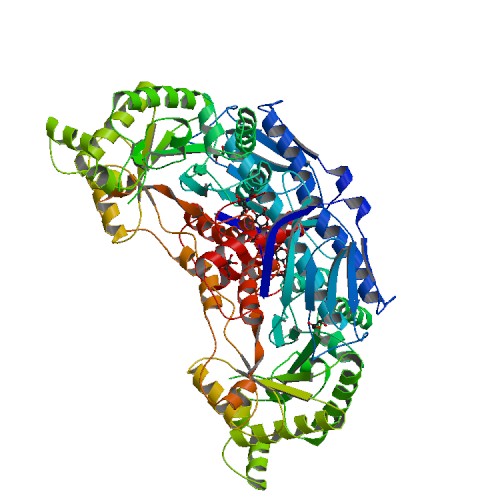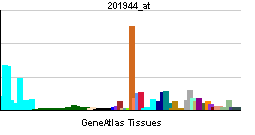HEXB
Hexosaminidase B (beta polypeptide), also known as HEXB, is a human gene.[1]
Hexosaminidase B is the beta subunit of the lysosomal enzyme beta-hexosaminidase that, together with the cofactor GM2 activator protein, catalyzes the degradation of the ganglioside GM2, and other molecules containing terminal N-acetyl hexosamines. Beta-hexosaminidase is composed of two subunits, alpha and beta, which are encoded by separate genes. Both beta-hexosaminidase alpha and beta subunits are members of family 20 of glycosyl hydrolases. Mutations in the alpha or beta subunit genes lead to an accumulation of GM2 ganglioside in neurons and neurodegenerative disorders termed the GM2 gangliosidoses. Beta subunit gene mutations lead to Sandhoff disease (GM2-gangliosidosis type II).[1]
References
Further reading
- Mahuran DJ (1991). "The biochemistry of HEXA and HEXB gene mutations causing GM2 gangliosidosis". Biochim. Biophys. Acta. 1096 (2): 87–94. PMID 1825792.
- Mahuran DJ (1999). "Biochemical consequences of mutations causing the GM2 gangliosidoses". Biochim. Biophys. Acta. 1455 (2–3): 105–38. PMID 10571007.
- Gilbert F, Kucherlapati R, Creagan RP; et al. (1975). "Tay-Sachs' and Sandhoff's diseases: the assignment of genes for hexosaminidase A and B to individual human chromosomes". Proc. Natl. Acad. Sci. U.S.A. 72 (1): 263–7. PMID 1054503.
- McInnes B, Potier M, Wakamatsu N; et al. (1992). "An unusual splicing mutation in the HEXB gene is associated with dramatically different phenotypes in patients from different racial backgrounds". J. Clin. Invest. 90 (2): 306–14. PMID 1386607.
- Bolhuis PA, Bikker H (1993). "Deletion of the 5'-region in one or two alleles of HEXB in 15 out of 30 patients with Sandhoff disease". Hum. Genet. 90 (3): 328–9. PMID 1487253.
- Wakamatsu N, Kobayashi H, Miyatake T, Tsuji S (1992). "A novel exon mutation in the human beta-hexosaminidase beta subunit gene affects 3' splice site selection". J. Biol. Chem. 267 (4): 2406–13. PMID 1531140.
- Banerjee P, Siciliano L, Oliveri D; et al. (1992). "Molecular basis of an adult form of beta-hexosaminidase B deficiency with motor neuron disease". Biochem. Biophys. Res. Commun. 181 (1): 108–15. PMID 1720305.
- Boose JA, Tifft CJ, Proia RL, Myerowitz R (1992). "Synthesis of a human lysosomal enzyme, beta-hexosaminidase B, using the baculovirus expression system". Protein Expr. Purif. 1 (2): 111–20. PMID 1967020.
- Mahuran DJ (1990). "Characterization of human placental beta-hexosaminidase I2. Proteolytic processing intermediates of hexosaminidase A.". J. Biol. Chem. 265 (12): 6794–9. PMID 2139028.
- Neote K, McInnes B, Mahuran DJ, Gravel RA (1990). "Structure and distribution of an Alu-type deletion mutation in Sandhoff disease". J. Clin. Invest. 86 (5): 1524–31. PMID 2147027.
- Neote K, Brown CA, Mahuran DJ, Gravel RA (1991). "Translation initiation in the HEXB gene encoding the beta-subunit of human beta-hexosaminidase". J. Biol. Chem. 265 (34): 20799–806. PMID 2147427.
- Dlott B, d'Azzo A, Quon DV, Neufeld EF (1990). "Two mutations produce intron insertion in mRNA and elongated beta-subunit of human beta-hexosaminidase". J. Biol. Chem. 265 (29): 17921–7. PMID 2170400.
- Nakano T, Suzuki K (1989). "Genetic cause of a juvenile form of Sandhoff disease. Abnormal splicing of beta-hexosaminidase beta chain gene transcript due to a point mutation within intron 12". J. Biol. Chem. 264 (9): 5155–8. PMID 2522450.
- Hubbes M, Callahan J, Gravel R, Mahuran D (1989). "The amino-terminal sequences in the pro-alpha and -beta polypeptides of human lysosomal beta-hexosaminidase A and B are retained in the mature isozymes". FEBS Lett. 249 (2): 316–20. PMID 2525487.
- O'Dowd BF, Quan F, Willard HF; et al. (1985). "Isolation of cDNA clones coding for the beta subunit of human beta-hexosaminidase". Proc. Natl. Acad. Sci. U.S.A. 82 (4): 1184–8. PMID 2579389.
- Bikker H, van den Berg FM, Wolterman RA; et al. (1989). "Demonstration of a Sandhoff disease-associated autosomal 50-kb deletion by field inversion gel electrophoresis". Hum. Genet. 81 (3): 287–8. PMID 2921040.
- Bolhuis PA, Oonk JG, Kamp PE; et al. (1987). "Ganglioside storage, hexosaminidase lability, and urinary oligosaccharides in adult Sandhoff's disease". Neurology. 37 (1): 75–81. PMID 2948136.
- Proia RL (1988). "Gene encoding the human beta-hexosaminidase beta chain: extensive homology of intron placement in the alpha- and beta-chain genes". Proc. Natl. Acad. Sci. U.S.A. 85 (6): 1883–7. PMID 2964638.
- Mahuran DJ, Neote K, Klavins MH; et al. (1988). "Proteolytic processing of pro-alpha and pro-beta precursors from human beta-hexosaminidase. Generation of the mature alpha and beta a beta b subunits". J. Biol. Chem. 263 (10): 4612–8. PMID 2965147.

